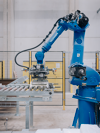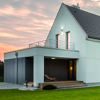
Premium quality for the industry? We get it done!
The use of application systems for the industrial sector depends on one thing above all: products need to be optimally integrated into production processes without any loss of efficiency and performance. The use of high-quality and innovative industrial coatings can give you a decisive advantage.
This is why we focus exclusively on the highest quality and maximum performance down to the last detail for our entire product range. We combine tradition with innovation and experience with expertise. With our system solutions that we research and develop in-house, our partners from industry, trade and commerce have been achieving exceptional results nationally and internationally for many years. A standard you can rely on!
Industry from A to Z
You are facing the challenge of combining function and aesthetics. However, you are confronted with growing demands when it comes to time, material and work efficiency. You are also faced with the ever-increasing expectations of your customers. With years of experience in the industrial environment, we know exactly what the challenges are. Our solution: high-performance products that are tailored to suit your needs, featuring straightforward application and seamless integration within a system. From suitable surface coatings for interior and exterior windows and doors to prefabricated house construction – we are on hand to provide comprehensive support from A to Z.

Process-stable industrial coatings for a long-lasting finish
Commercial industrial coatings are often inexpensive, but only cover the basic requirements. The longevity of the results is limited and detailed customised solutions are rarely possible. This is where we come in, because we believe that real quality still makes the difference today.
Wooden window and door coatings
Windows and doors not only have to withstand high thermal and mechanical loads, they also need to blend in perfectly with the building design. Our window and exterior door coatings combine a high level of protection with a wide range of design options. Our Induline system solutions are a true all-rounder that can be used for everything from single small batches up to industrial series production. This is what sets our Induline series apart:
- Significantly better levelling and pore wetting properties
- Extremely high covering power in the lower layer thickness range
- High early usability and block resistance
- Early water resistance and protection against water stains
- Elegant surface finish with very good resistance to hand cream
- Resistance to soiling
- Durabile and permanently elastic coating

Coating systems for the timber industry
Our coating systems for the wood industry are specially tailored to components with limited or no dimensional stability, such as solid structural timber, laminated veneer lumber made from softwood or beech, multi-ply boards and planed goods. We offer durable impregnation treatments and primers for professional, industrial use. What's more, many other applications are possible with translucent and opaque coatings for a wide array of situations and designs, as well as economical and versatile coating systems. Our special products for customised functional coating systems enable you to achieve the best results down to the last detail.
Floor coatings for the industry
Floors in industrial, retail and commercial environments are exposed to heavy loads. They must be able to withstand heavy functional stresses, for example from forklift trucks or high pedestrian traffic, remain hygienic and easy to maintain and also look good. Our robust industrial floor coatings in the form of parquet and design flooring open up a wealth of potential applications, from classic parquet or trendy vinyl flooring to flooring based on high-density fibreboard, wood-plastic composites, and so on. It is also possible to create authentic reproductions, e.g. of wood, stone, metal and ceramic effects using digital printing.
Resin flooring has proven its worth in applications with strict hygiene requirements, for instance in the food industry. This flooring type is hard-wearing and seamless, so there are no gaps where stubborn dirt could settle.

Remmers Prefab: Products for the prefab industry
Living space is becoming increasingly scarce. The German government has therefore set targets for how much new housing should be built. However, these targets cannot be achieved through traditional residential construction. For this reason, the prefabricated house industry is becoming increasingly popular. We can support you in maximising prefabrication on your construction site, helping you to meet the stringent requirements in terms of energy and moisture protection while also achieving the very highest design standards. With Remmers Prefab, we provide you with maximum support in the solid-built house industry, prefabricated house industry, industrial construction and the precast concrete industry.

Service and advice in your region
You can decide how you would like to use our service. We are on hand to provide personal support, online or on site. You can also reach out to our specialists in your local area. On our product pages, application pages or in our segment brochures, you will find plenty of information to get you started. We will also be happy to advise you individually for your project. With a great deal of expertise and many years of experience, we are your partner for top results.


















